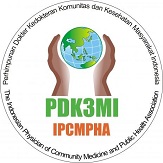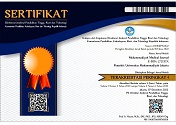The Outcome of Patients with Sepsis at Tarakan Hospital Central Jakarta in 2018
DOI:
https://doi.org/10.24853/mmj.2.2.49-54Keywords:
mortality, outcome, sepsisAbstract
Background: Sepsis is a common, life-threatening organ dysfunction caused by a dysregulated host response to infection. In 2017, estimated cases for sepsis reached 48.9 million worldwide, with 11 million deaths. Adequate antibiotic therapy is crucial for the treatment of sepsis. Purposes: The objective of this study is to find factors related to sepsis patient outcomes. Methods: We conducted a 1-year retrospective descriptive study with the inclusion criteria of all adult sepsis patients in Tarakan District Hospital in 2018. We compiled 39 samples that fit the inclusion criteria. Results: The distribution gender of this study were 51.2% female and 48.8% male patients; with most patients in the age of <65 years old (53.8%), <7 days in the length of stay (72%), and the most common source of infection was gastrointestinal (33.3%) followed by lungs (28.2%). Conclusion: We found a mortality rate of 59%, with the most common source of infection leading to death was the lungs (81.2%) and treated with single ceftriaxone antibiotic therapy (78.3%). Another factor associated with mortality is inadequate single antibiotic therapy.References
Simpson SQ. New Sepsis Criteria, A Change We Should Not Make. Chest. 2016;149(5):1117–8.
Polat G, Ugan RA, Cadirci E, Halici Z. Sepsis and Septic Shock : Current Treatment Strategies and New Approaches Sepsis ve Septik Şok : Mevcut Tedavi Stratejileri ve Yeni Yaklaşımlar. Eurasian J Med. 2017 ;53–8.
Gul F, Arslantas MK, Cinel I, Kumar A. Changing Definitions of Sepsis. Turk J Anaesthesiol Reanim. 2017 ;129–38.
Gotts JE, Matthay MA. Sepsis : pathophysiology and clinical management. Bmj. 2016;1–20.
Gyawali B, Ramakrishna K, Dha moon AS. Sepsis : The evolution in definition , pathophysiology , and management. SAGE Open Med. 2019;
Irvan I, Febyan F, Suparto S. Sepsis dan Tata Laksana Berdasar Guideline Terbaru. J Anestesiol Indones. 2018;X:62–73.
Rudd KE, Johnson SC, Agesa KM, Shackelford KA, Tsoi D, Kievlan DR, et al. Global , regional , and national sepsis incidence and mortality , 1990 – 2017 : analysis for the Global Burden of Disease Study. Lancet. 2020;395(10219):200–11.
Keputusan Menteri Kesehatan Republik Indonesia Nomor HK.01. 07/Menkes/342/2017 Tentang Pedo-man Nasional Pelayanan Kedokteran Tata Laksana Sepsis. 2017. p. 1–82.
Chen C, Cheng K, Chan K, Yu W. Age May Not In fl uence the Outcome of Patients with Severe Sepsis in Intensive Care Units q. Int J Gerontol. 2014;8(1):22–6.
Loeches M, Intensive A, Loeches IM, Guia MC, Vallecoccia MS, Suarez D, et al. Risk factors for mortality in elderly and very elderly critically ill patients with sepsis : a prospective, observational, multi center cohort study. Ann Intensive Care. 2019;
Pietropaoli AP, Glance LG, Oakes D, Fisher SG. Gender Differences in Mortality in Patients With Severe Sepsis or Septic Shock. Gend Med. 2010;7(5):422–37.
Rhodes A, Evans LE, Alhazzani W, Levy MM, Antonelli M, Ferrer R, et al. Surviving Sepsis Campaign : International Guidelines for Management of Sepsis and Septic Shock : 2016. Vol. 43, Intensive Care Medicine. Springer Berlin Heidelberg; 2017. 304–377 p.
Evans T. Diagnosis and Management of Sepsis. Clin Med (Northfield Il). 2018;18:146–9.
Angus DC, Poll T Van Der. Severe Sepsis and Septic Shock. N Engl J Med. 2013;
Micek ST, Welch EC, Khan J, Pervez M, Doherty JA, Reichley RM, et al. Empiric combination antibiotic therapy is associated with improved outcome against sepsis due to gram-negative bacteria: A retrospective analysis. Antimicrob Agents Chemother. 2010;54(5): 1742–8.
Asner SA, Desgranges F, Schrijver IT, Calandra T. Impact of the timeliness of antibiotic therapy on the outcome of patients with sepsis and septic shock. J Infect. 2021;82(5):125–34.
Katu S, Suwarto S, Pohan HT, Abdullah M. Faktor-Faktor yang Mempengaruhi Keberhasilan Terapi Antibiotik Empirik pada Pasien Sepsis Berat dan Syok Sepsis di Bangsal Rawat Inap Penyakit Dalam Rumah Sakit Cipto Mangunkusumo. J Penyakit Dalam Indones. 2015;2(2):96–106.
Nasir N, Jamil B, Siddiqui S, Talat N, Khan FA, Husain R. Mortality in Sepsis and its relationship with Gender. Pakistan J Med Sci. 2015 ;31(5):1201–6.
Rowe TA, Mckoy JM. Sepsis in Older Adults. Infect Dis Clin NA. 2017;31(4):731–42.
Abe T, Ogura H, Kushimoto S, Shiraishi A, Sugiyama T. Variations in infection sites and mortality rates among patients in intensive care units with severe sepsis and septic shock in. J intensive care. 2019;1–9.
Viale P, Tedeschi S, Scudeller L, Attard L, Badia L, Bartoletti M, et al. Infectious Diseases Team for the Early Management of Severe Sepsis and Septic Shock in the Emergency. Clin Infect Dis. 2017;65(Id):1253–9.
Chou EH, Mann S, Hsu T, Hsu W, Liu CC, Bhakta T, et al. Incidence , trends , and outcomes of infection sites among hospitalizations of sepsis : A nationwide study. PLoS One. 2020;1–13.
Downloads
Published
Issue
Section
License
Authors who publish in the Muhammadiyah Medical Journal agree to the following terms:
- Authors retain copyright and grant Muhammadiyah Medical Journal right of first publication with the work simultaneously licensed under a Creative Commons Attribution Licence that allows others to adapt (remix, transform, and build) upon the work non-commercially with an acknowledgement of the work's authorship and initial publication in Muhammadiyah Medical Journal.
- Authors are permitted to share (copy and redistribute) the journal's published version of the work non-commercially (e.g., post it to an institutional repository or publish it in a book), with an acknowledgement of its initial publication in Muhammadiyah Medical Journal.








